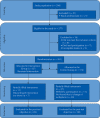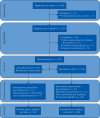Attitudes of health professionals towards suicidal behavior: an intervention study
- PMID: 35703608
- PMCID: PMC9239338
- DOI: 10.11606/s1518-8787.2022056003320
Attitudes of health professionals towards suicidal behavior: an intervention study
Abstract
Objective: To evaluate the effect of an educational intervention on the attitudes of primary healthcare providers regarding patients with suicidal behavior.
Methods: Clinical trial randomized by clusters, with a sample of 261 healthcare professionals, from 22 health units selected by stratified sampling, were chosen and randomly allocated, by drawing, into two groups: intervention (n = 87) and control (n = 174). The participants of the intervention group were exposed to a 20-hour training on suicidal behavior. All 261 participants were evaluated before and after the intervention; the groups were compared to evaluate their attitude towards suicidal behavior using the Suicide Behavior Attitude Questionnaire (SBAQ), an evaluation made by comparison of the means via t-Student test, for independent samples, and paired t-test, for dependent samples.
Results: The intervention group, in comparison to their evaluation before and after training, as well as in the comparison with the evaluation of the control group, showed statistically significant differences in attitudes towards suicidal behavior, according to the differences presented in the scores for the domains: "perception of professional capacity," in all four items; "negative feeling," in six of the seven items; and in the "right to commit suicide" domain, in three of the five items.
Conclusion: The brief training developed in primary health care was effective to improve the attitudes of the participants who were part of the intervention group regarding patients with suicidal behavior.
OBJETIVO: Avaliar o efeito de uma intervenção educativa sobre comportamento suicida nas atitudes dos profissionais de saúde da atenção primária.
MÉTODO: Ensaio clínico randomizado por conglomerados, com amostra de 261 profissionais de saúde, provenientes de 22 unidades de saúde selecionados por amostragem estratificada, elegidos e alocados aleatoriamente, mediante sorteio, em dois grupos: intervenção (n = 87) e controle (n = 174). Os participantes do grupo intervenção foram expostos a uma capacitação sobre comportamento suicida com duração de 20 horas. Todos os 261 participantes foram avaliados, antes e após a intervenção, e os grupos foram comparados para avaliar a atitude frente ao comportamento suicida utilizando o Suicide Behavior Attitude Questionnaire (SBAQ), avaliação feita por comparação das médias via teste t-Student para amostras independentes e Teste t pareado para amostras dependentes.
RESULTADOS: O grupo intervenção, na comparação intragrupos antes e depois da capacitação, bem como na comparação com o grupo controle, demonstrou diferenças estatisticamente significativas nas atitudes frente ao comportamento suicida, avaliadas a partir das diferenças de scores nos domínios: “percepção da capacidade profissional”, em todos os quatro itens; “sentimento negativo”, em seis dos sete itens; e no domínio “direito ao suicídio”, três dos cinco itens.
CONCLUSÃO: A capacitação breve desenvolvida na atenção primária à saúde foi efetiva para a melhora das atitudes dos participantes que integravam o grupo intervenção frente ao comportamento suicida.
Conflict of interest statement
Figures
Similar articles
-
Nursing students' attitudes towards suicide and suicidal patients: A multicentre cross-sectional survey.Nurse Educ Today. 2022 Feb;109:105258. doi: 10.1016/j.nedt.2021.105258. Epub 2021 Dec 24. Nurse Educ Today. 2022. PMID: 34968930
-
Does a brief training on suicide prevention among general hospital personnel impact their baseline attitudes towards suicidal behavior?J Affect Disord. 2007 Jun;100(1-3):233-9. doi: 10.1016/j.jad.2006.09.035. Epub 2006 Oct 23. J Affect Disord. 2007. PMID: 17056123
-
Attitudes towards suicidal behaviour and associated factors among nursing professionals: A quantitative study.J Psychiatr Ment Health Nurs. 2017 Nov;24(9-10):651-659. doi: 10.1111/jpm.12413. Epub 2017 Sep 4. J Psychiatr Ment Health Nurs. 2017. PMID: 28741801
-
Exploring Health Care Professionals' Knowledge of, Attitudes Towards, and Confidence in Caring for People at Risk of Suicide: a Systematic Review.Arch Suicide Res. 2020;24(sup2):S1-S31. doi: 10.1080/13811118.2019.1586608. Epub 2019 Apr 22. Arch Suicide Res. 2020. PMID: 30856366
-
Examination of medical student and physician attitudes towards suicide reveals need for required training.Front Public Health. 2024 Apr 3;12:1331208. doi: 10.3389/fpubh.2024.1331208. eCollection 2024. Front Public Health. 2024. PMID: 38633234 Free PMC article. Review.
Cited by
-
Pharmacists' Experiences, Perceptions, and Attitudes towards Suicide and Suicide Prevention: A Scoping Review.Pharmacy (Basel). 2023 Jan 30;11(1):25. doi: 10.3390/pharmacy11010025. Pharmacy (Basel). 2023. PMID: 36827663 Free PMC article.
-
Attitudinal Beliefs About Suicidal Behavior and Attitudes Towards Suicide Attempts in Colombian Healthcare Professionals.Healthcare (Basel). 2024 Oct 31;12(21):2169. doi: 10.3390/healthcare12212169. Healthcare (Basel). 2024. PMID: 39517381 Free PMC article.
References
-
- World Health Organization. Suicide data. WHO Press: Geneva (CH): WHO; 2019 [cited 2020 Mar 16]. Available from: https://www.who.int/data/gho/data/themes/mental-health/suicide-rates
-
- Ministério da Saúde (BR), Secretaria de Vigilância em Saúde. Perfil epidemiológico das tentativas e óbitos por suicidio no Brasil e a Rede de Atenção à Saúde. Bol Epidemiol. 2017 [cited 2020 Mar 16];40(30):1-14. Available from: https://www.gov.br/saude/pt-br/centrais-de-conteudo/2017-025-perfil-epid...
-
- Cohen AA, Magnezi R, Weinstein O. Review and analysis of mental health reforms in several countries: implementation, comparison and future challenges. Ann Psychiatry Treat. 2020;4(1):13-24. 10.17352/apt.000015 - DOI
Publication types
MeSH terms
LinkOut - more resources
Full Text Sources
Medical



